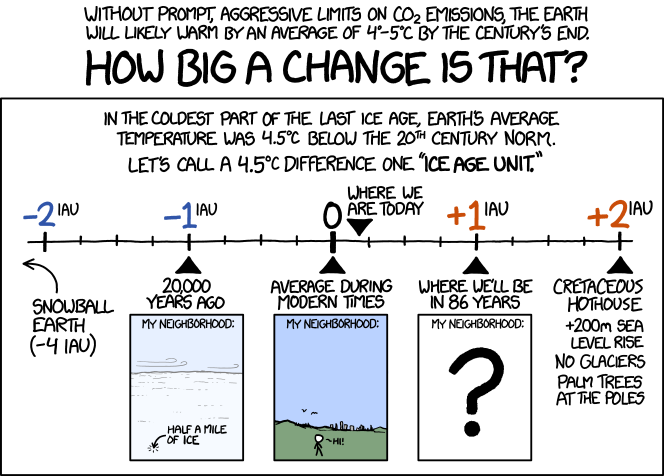Why a 4 degree global temperature increase is the new game in town

By Dr Anthony Horton
Numerous recent initiatives intend to precipitate action on greenhouse gas (GHG) emissions in the lead up to the Paris Climate Summit, which is now less than 2 months away. In recent weeks, approximately 2000 people and 400 organisations have made commitments to cease investments in fossil fuel producing companies. Countries were asked to nominate actions they would undertake to reduce GHG emissions to the United Nations Framework Convention on Climate Change (UNFCCC) by October 1.
A US Clean Power Plan which was announced in August this year could reduce carbon dioxide emissions from power stations by 870 million tonnes by 2030 (equivalent of taking 166 million cars off the road). China has committed to peak emissions by 2030, and there are indications that emissions may peak before that. Two weeks ago on September 25, China announced that a national carbon emissions trading scheme would commence in 2017. Shortly after that, Brazil announced a 43% cut in greenhouse gas emissions from 2005 levels by 2030.
When the Paris Climate Summit begins, the parties negotiating a deal need to consider the extent to which global warming is already occurring. Global carbon dioxide emissions in 2012 were 58% higher than they were in 1990 and atmospheric carbon dioxide concentrations have increased from approximately 340 parts per million (ppm) in 1980 to nearly 400ppm today. It is a commonly held belief that in order to limit warming to 2°C the total amount of carbon dioxide in the atmosphere must stay below 1 trillion tonnes.
According to the Intergovernmental Panel on Climate Change (IPCC), we were more than half way to 1 trillion tonnes in 2011 with a total amount of 515 billion tonnes in the atmosphere. If global greenhouse gas emissions continue at the rate of 140 billion tonnes each year, temperatures may rise by up to 4.5°C by 2100. Even if each country fully honours its Paris pledge, it is possible that global temperatures may increase by 3.5°C by then.
Global average temperatures are approximately 0.8°C higher than before the Industrial Revolution and a recent study in the journal Science showed that a suspected warming hiatus between 1998 and 2012 didn’t occur-the cooler temperatures arose from measurements from ocean buoys rather than ships. A subsequent study also found flaws in the statistical modelling in the research that pointed to the hiatus.
The world’s oceans are absorbing most of the heat which is being added to the Earth’s climate system. Arctic sea ice coverage in summer has reduced by more than 40% over the past 40 years, and mean sea levels have risen by approximately 20cm since 1880 and could rise by up to 1 metre more by 2100. The Kiribati Government has recently purchased land in Fiji to accommodate residents in the case of flooding.
Given that fresh water is less dense than salt water, melting sheets of ice interrupt oceanic circulation patterns. It is possible that Europe’s climate may cool slightly as a result of the Atlantic meridional driving cold salt water into the deep ocean and warm water northward. The changes in ocean currents may also be shifting jet streams and altering storm patterns.
According to Simon Lewis from University College London, forest fires in Indonesia could release up to 2 billion tonnes of carbon dioxide. Recent US fires have consumed more than 2 million hectares of forest. Alaska fared worst due to soot from the fires darkening the ice and reducing its ability to reflect solar radiation away from the Earth.
The Arctic region is reportedly warming twice as fast as the rest of the Earth, and if the permafrosts (that store 1,700 Gigatonnes or 1,700 billion tonnes of carbon) thaw out, huge amounts of methane will be released. The big problem with that is the global warming potential of methane is 25 times that of carbon dioxide.
In a paper recently published in Nature Climate Change, researchers from Universities of Cambridge and Colorado estimated that the economic impact of both methane and carbon dioxide being released could be as high as 0.7% of global gross domestic product (GDP) by 2200 using environmental models. Their research did however include a high level of uncertainty.
A little more than a week ago Governor of the Bank of England Mark Carney warned that measures necessary to avoid catastrophic climate change in the long term could result in huge losses in the shorter term by rendering oil, coal and gas essentially untouchable.
See more on the 4 degree warming scenario here.
I have to say I admire Christiana Figueres’ persistence in urging immediate action-seemingly on a weekly basis. As overseer of the Paris Climate Summit in December she has an unenviable task in obtaining an unprecedented global agreement. Her task is not made any easier given the justification with which some countries are defending their Paris commitments (despite considerable pressure from others) and their apparent lack of understanding that we are all residents of the one Earth.
Most developed countries understand that the old “business as usual” approach simply won’t cut it anymore and that they have a responsibility to take the needs of people in developing countries into account, especially as the majority of these countries have made little contribution to global greenhouse gas emissions. Announcements are being made virtually every day on social media regarding renewable energy initiatives and/or countries, states or towns that are moving from a reliance on fossil fuels to larger and larger percentages of renewables in their energy mix.
Whether the global average temperature increase by 2100 is predicted to be 2°C or 4°C, it is inevitable that countries need to join together and help each other, including their nearest neighbours. Australia’s recent move to “throw its toys out of the cot” if the UN established an organisation charged with the responsibility of assisting people that are fleeing from the ravages of climate change surely flies in the face of the need to help those around us.
This article was first published on The Climate Change Guy.
 About the author: Anthony Horton holds a PhD in Environmental Science, a Bachelor of Environmental Science with Honours and a Diploma of Carbon Management. He has a track record of delivering customised solutions in Academia, Government, the Mining Industry and Consulting based on the latest wisdom and his scientific background and experience in Climate/Atmospheric Science and Air Quality. Anthony’s work has been published in internationally recognised scientific journals and presented at international and national conferences, and he is currently on the Editorial Board of the Journal Nature Environment and Pollution Technology. Anthony also blogs on his own site, The Climate Change Guy.
About the author: Anthony Horton holds a PhD in Environmental Science, a Bachelor of Environmental Science with Honours and a Diploma of Carbon Management. He has a track record of delivering customised solutions in Academia, Government, the Mining Industry and Consulting based on the latest wisdom and his scientific background and experience in Climate/Atmospheric Science and Air Quality. Anthony’s work has been published in internationally recognised scientific journals and presented at international and national conferences, and he is currently on the Editorial Board of the Journal Nature Environment and Pollution Technology. Anthony also blogs on his own site, The Climate Change Guy.









4 comments
Login here Register here-
Don Wreford
-
Keith
-
metadatalata
-
Keith
Return to home pageThe civilian population must be responsible for global warming neither corporations nor military have any responsibility as to contribution to heating the planet? countries such as Syria do not have the energy to plant more trees yet they are accomplices to global warming yet outside countries having played a major part in war in Syria and else where are not making any serious effort to end this war, the imperialist countries having now become so depraved no longer have any morality commitment that the intelligent person would find creditable, all present governments are corrupt.
Vaks et al say that permafrost thaws at an increased temperature of 1.5C.
http://oncirculation.com/2013/04/18/using-stalagmites-to-measure-permafrost-melt/
When there are 6 flooding events in the US over a 5 year period, where the probability of each event occurring is on a 1 to 1,000 year basis, statistically you do wonder where we are heading. A small change in temperature appears to have large impacts.
http://thinkprogress.org/climate/2015/10/07/3709459/south-carolina-flooding-impacts/?utm_source=newsletter&utm_medium=email&utm_campaign=cptop3&elq=8e0dc11c6b5540dcb4b434679c95ea45&elqCampaignId=4032&elqaid=27502&elqat=1&elqTrackId=9a13355fb64348128760e67267df4e3a
There is a push to clear air pollution in a number of countries, particulates taken out of the atmosphere can lead to an increase in temperature.
“There is a push to clear air pollution in a number of countries, particulates taken out of the atmosphere can lead to an increase in temperature.”
Adding carcinogens to the air is not a preferred method to reduce global warming. Many large asian cities are already suffering with thousands of deaths each year attributable to air pollution. Basically, there is no easy option here but to take as many steps in as many ways as possible to change the way we inhabit the earth. We are going to need some new global rules about population control and resource management that will be binding anywhere on the planet with rewards to communities that excel in reducing carbon footprint and penalties for those that disregard the problem.
Great thought-provoking article.
@ metadatalata
My comment about particulates was more about showing the urgency in moving away from fossil fuels. In seeking to reduce CO2 emissions it is by no means a linear process.
Already hundreds of thousands of people die from the process of mining coal and then using it to create power. Numerous other people suffer from respiratory complaints as a result of coal emissions..
The negatives in not doing enough in relation to mitigating against climate change far exceed matters such as the degree of warming created by reducing pollution.
If we don’t take steps to make it possible to inhabit the earth, the planet will continue, we won’t.